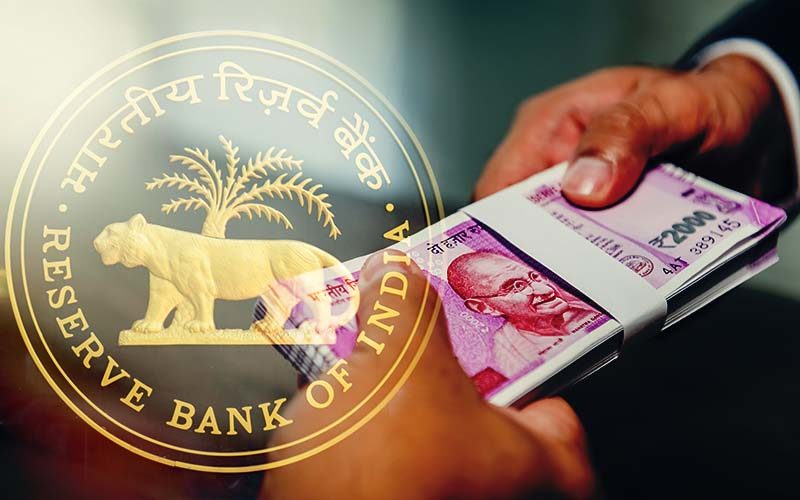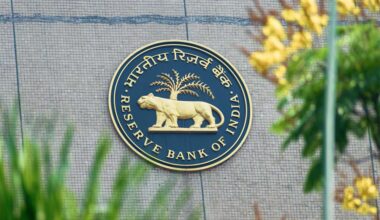Repo Rate is the rate at which the Reserve Bank of India (RBI) lends money to commercial banks or financial institutions in India against government securities. The current Repo Rate in 2023 is 6.50%. If the RBI lowers the Repo Rate, it increases the money supply in the market, which can help the economy grow. However, if the rate is high, it can slow down economic growth. This article explains what Repo Rate is, how it works, and how it affects the economy in India today.
Repo Rate Meaning and Repo Rate Definition?
The term Repo Rate refers to the interest rate at which a central bank, such as the Reserve Bank of India (RBI), lends money to commercial banks or financial institutions in exchange for government securities. The term ‘Repo’ stands for ‘Repurchase Option,’ and the interest rate charged by the central bank is known as the Repo Rate.
Changes in Repo Rate affect the economy as they can influence the flow of money in the market. When the central bank lowers the Repo Rate, it can lead to an expansion of the economy by increasing the money supply. Conversely, when the central bank raises the Repo Rate, it can restrict economic growth by reducing the money supply.
What is Repo Rate In India?
The current RBI bank repo rate in India holds significant importance in the country’s financial landscape. As of February 8, 2023, the Reserve Bank of India (RBI), through its Monetary Policy Committee (MPC), made a noteworthy announcement by increasing the repo rate by 0.25%, resulting in a latest repo rate of 6.50%. This decision follows a prior adjustment on December 7, 2022, when the repo rate stood at 6.25%.
Importance of RBI Bank Repo Rate
The Repo Rate is an important tool used in the Reserve Bank of India’s (RBI) Monetary Policy. The RBI Governor leads a group called the Monetary Policy Committee (MPC), which typically includes six members. They work together to create, manage, and adjust policy rates based on the country’s liquidity situation. The RBI adjusts policy rates depending on whether there is a shortage or surplus of funds in the country. When banks borrow money from the RBI using Repo Rate, there are certain aspects to the transaction that takes place between them.
- The RBI lends money to banks through a legal agreement that requires collateral, which can be securities and bonds.
- The RBI uses securities from banks to lend monetary help, and hedges and leverages against them.
- Repo Rate loans or transactions are short-term borrowings, with banks getting overnight or term funds while the RBI holds the securities.
- Banks can repurchase securities on a specified date and at a predetermined price, with the interest amount calculated on the loan amount.
- If banks fail to repay the cash on a predetermined date, the RBI is authorized to sell these securities.
- Banks may borrow money to deal with a deficiency of cash reserves or to maintain the minimum reserve balance as a statutory measure
How Does RBI Calculate Repo Rate?
The Reserve Bank of India (RBI) calculates the repo rate based on various factors and market conditions. The repo rate is the rate at which the RBI lends money to commercial banks. Here’s a simplified explanation of how the RBI calculates the repo rate:
- Assessment of Inflation: The RBI closely monitors the inflation rate in the economy. Inflation is the rate at which prices of goods and services rise over time. If the RBI perceives inflation to be high, it may increase the repo rate to curb spending and reduce demand, thus controlling inflation.
- Economic Growth: The RBI also considers the state of economic growth while deciding the repo rate. Higher repo rates can slow down economic growth by making borrowing more expensive for businesses and individuals. Conversely, lower repo rates can stimulate economic activity by making borrowing more affordable.
- Liquidity in the Banking System: The RBI assesses the liquidity conditions in the banking system, which refers to the availability of funds for lending and borrowing. If there is excess liquidity, the RBI may choose to increase the repo rate to absorb the surplus funds. Conversely, if there is a shortage of liquidity, the RBI may reduce the repo rate to encourage banks to borrow and lend more.
- Monetary Policy Committee (MPC): The RBI’s Monetary Policy Committee, consisting of six members, meets periodically to assess the economic situation and decide on the repo rate. The committee considers various factors, including inflation, growth projections, and global economic trends, before making a decision.
It’s important to note that the calculation of the repo rate is a complex process that involves analysis of multiple economic indicators and expert judgment. The RBI’s objective is to maintain price stability and promote economic growth while considering various factors affecting the economy.
RBI Repo Rate History Timeline in India: 2005-2023
| Date of Change | Current Repo Rate | Change Percentage |
|---|---|---|
| 8 June 2023 | 6.50% | 0.25% |
| 8 February 2023 | 6.50% | 0.25% |
| 7 December 2022 | 6.25% | 0.35% |
| 30 September 2022 | 5.90% | 0.5% |
| 5 August 2022 | 5.40% | 0.5% |
| 8 June 2022 | 4.90% | 0.5% |
| May 2022 | 4.40% | 0.4% |
| 09 Oct 2020 | 4.00% | 0.00% |
| 06 Aug 2020 | 4.00% | 0.00% |
| 22 May 2020 | 4.00% | 0.40% |
| 27 March 2020 | 4.40% | 0.75% |
| 6 February 2020 | 5.15% | 0.25% |
| 07 August 2019 | 5.40% | 0.35% |
| 06 June 2019 | 5.75% | 0.25% |
| 04 April 2019 | 6.00% | 0.25% |
| 07 February 2019 | 6.25% | 0.25% |
| 01 August 2018 | 6.50% | 0.25% |
| 06 June 2018 | 6.25% | 0.25% |
| 02 August 2017 | 6.00% | 0.25% |
| 04 October 2016 | 6.25% | 0.25% |
| 05 April 2016 | 6.50% | 0.25% |
| 29 September 2015 | 6.75% | 0.50% |
| 02 June 2015 | 7.25% | 0.25% |
| 04 March 2015 | 7.50% | 0.25% |
| 15 January 2015 | 7.75% | 0.25% |
| 28 January 2014 | 8.00% | -0.25% |
| 29 October 2013 | 7.75% | -0.25% |
| 20 September 2013 | 7.50% | -0.25% |
| 03 May 2013 | 7.25% | -0.50% |
| 17 March 2011 | 6.75% | -0.25% |
| 25 January 2011 | 6.50% | -0.25% |
| 02 November 2010 | 6.25% | -0.25% |
| 16 September 2010 | 6.00% | -0.25% |
| 27 July 2010 | 5.75% | -0.25% |
| 02 July 2010 | 5.50% | -0.25% |
| 20 April 2010 | 5.25% | -0.25% |
| 19 March 2010 | 5.00% | -0.25% |
| 21 April 2009 | 4.75% | 0.25% |
| 05 March 2009 | 5.00% | 0.50% |
| 05 January 2009 | 5.50% | 1.00% |
| 08 December 2008 | 6.50% | 1.00% |
| 03 November 2008 | 7.50% | 0.50% |
| 20 October 2008 | 8.00% | 1.00% |
| 30 July 2008 | 9.00% | -0.50% |
| 25 June 2008 | 8.50% | -0.50% |
| 12 June 2008 | 8.00% | -0.25% |
| 30 March 2007 | 7.75% | -0.25% |
| 31 January 2007 | 7.50% | -0.25% |
| 30 October 2006 | 7.25% | -0.25% |
| 25 July 2006 | 7.00% | -0.50% |
| 24 January 2006 | 6.50% | -0.25% |
| 26 October 2005 | 6.25% | 0.00% |
How Does Repo Rate Function?
Banks can borrow money from the RBI by pledging securities and repurchasing them the following day. This is a short-term loan option, typically for just one day, and is meant to help banks face a cash crunch. However, sometimes banks may need this loan for more than one day. In such cases, it is called a Term Repo or Variable Rate Term Repo, and the RBI typically announces an auction for it. The term can range from 7 to 28 days.
The Overnight Repo rate and the Term Repo rate are influenced by inflation rates. When the inflation rate is higher than what the RBI considers acceptable, it may increase the Repo Rate to help control it. Increasing the Repo Rate can also help infuse liquidity in the market with a lower cost of funds for borrowers.
What Effect Does the New Repo Rate Have on the Life of a Common Man?
The new repo rate set by the Reserve Bank of India (RBI) can have an impact on the life of a common man in several ways:
- Interest Rates on Loans: The repo rate directly affects the interest rates on loans, such as home loans, car loans, and personal loans. When the repo rate increases, banks may raise their lending rates, making borrowing more expensive for individuals. This can result in higher EMIs (Equated Monthly Installments) and increased financial burden for borrowers.
- Fixed Deposit Rates: The repo rate also influences the interest rates offered on fixed deposits by banks. When the repo rate is high, banks may increase the fixed deposit rates, which can benefit individuals who rely on fixed income from their investments. However, if the repo rate decreases, banks may lower the fixed deposit rates, affecting the returns for depositors.
- Inflation and Cost of Living: The repo rate plays a crucial role in controlling inflation in the economy. When the repo rate is increased to curb inflation, it can lead to a decrease in consumer spending and demand for goods and services. This can indirectly impact the cost of living for a common man as prices of goods and services may stabilize or decrease due to reduced demand.
- Economic Growth and Job Market: The repo rate is also used as a tool to stimulate or control economic growth. When the repo rate is lowered, it encourages borrowing and investment, leading to increased economic activity and potentially creating job opportunities. On the other hand, if the repo rate is increased to control inflation, it may slow down economic growth, which can impact the job market and employment prospects for individuals.
It’s important to note that the impact of the repo rate on the life of a common man can vary depending on individual circumstances, such as their financial situation, borrowing needs, and investment choices. It’s advisable for individuals to stay informed about changes in the repo rate and its implications to make informed financial decisions.
Relationship Between Inflation and Present Repo Rate
There is a close relationship between inflation and the present repo rate set by the Reserve Bank of India (RBI). The repo rate is one of the monetary policy tools used by the RBI to manage inflation in the economy. Here’s how inflation and the repo rate are connected:
- Controlling Inflation: One of the primary objectives of the RBI is to maintain price stability, which means keeping inflation within a target range. When the RBI perceives inflation to be high or rising, it may increase the repo rate. By raising the repo rate, the RBI aims to reduce the money supply in the economy, making borrowing more expensive for banks. This, in turn, can lead to reduced borrowing and spending by individuals and businesses, thereby curbing demand and controlling inflation.
- Impact on Borrowing Costs: The repo rate directly affects the interest rates at which commercial banks borrow from the RBI. When the repo rate is increased, banks often pass on the higher borrowing costs to their customers by raising lending rates on loans. This can make borrowing more expensive for individuals and businesses, reducing their spending and demand. The decreased spending can help moderate inflationary pressures in the economy.
- Influence on Consumer and Producer Prices: Inflation is the rate at which consumer prices (CPI) or producer prices (WPI) rise over time. Changes in the repo rate can have an indirect impact on consumer and producer prices. When the repo rate is increased, it can lead to tighter credit conditions, which can lower the demand for goods and services. Reduced demand can put downward pressure on prices, helping to curb inflation. Conversely, when the repo rate is lowered, it can stimulate borrowing and spending, potentially leading to increased demand and upward pressure on prices.
It’s important to note that the relationship between inflation and the repo rate is not always linear or immediate. The impact of changes in the repo rate on inflation may take time to materialize and can be influenced by other factors such as fiscal policies, global economic conditions, and supply-side shocks. The RBI closely monitors these factors and adjusts the repo rate accordingly to maintain price stability in the economy.
How Does Repo Rate Affect Home Loan?
The repo rate set by the Reserve Bank of India (RBI) can have an impact on home loans in the following ways:
- Interest Rates: Home loan interest rates are influenced by the repo rate. When the repo rate increases, banks may raise their lending rates, including home loan interest rates. This means that if the repo rate goes up, borrowers may have to pay higher interest on their home loans. Conversely, when the repo rate decreases, banks may lower their lending rates, potentially leading to reduced home loan interest rates.
- EMIs (Equated Monthly Installments): Changes in home loan interest rates can affect the EMIs that borrowers need to pay. If the repo rate increases and home loan interest rates go up, the EMIs may increase, resulting in higher monthly payments for borrowers. On the other hand, if the repo rate decreases and home loan interest rates decline, the EMIs may decrease, providing some relief to borrowers in terms of their monthly financial obligations.
- Affordability and Loan Eligibility: Home loan affordability and eligibility can also be impacted by changes in the repo rate. When the repo rate increases and home loan interest rates rise, it can reduce the loan amount that borrowers are eligible for, making it more challenging to afford a home purchase. Conversely, when the repo rate decreases and home loan interest rates decline, borrowers may become eligible for higher loan amounts, potentially increasing their affordability.
- Refinancing Opportunities: Changes in the repo rate can create opportunities for home loan refinancing. If the repo rate decreases significantly, borrowers who have higher interest rate home loans may consider refinancing their loans to take advantage of the lower interest rates. Refinancing can help borrowers reduce their monthly payments and save on interest costs over the loan tenure.
How Does Repo Rate Affect Fixed Deposits (FDs)?
- Influence on Interest Rates: When the central bank increases the repo rate, it becomes more expensive for commercial banks to borrow money. As a result, banks may raise their lending rates, including the interest rates on FDs, to maintain profitability.
- Higher FD Returns: An increase in the repo rate often leads to higher interest rates on FDs. This means that individuals who invest in FDs during such periods may benefit from higher returns on their investments.
- Attractive Investment Option: When interest rates on FDs rise due to an increase in the repo rate, FDs become a more attractive investment option for individuals seeking stable returns. This can lead to an increased demand for FDs.
- Impact on Existing FDs: Changes in the repo rate usually do not affect the interest rates on existing FDs. The interest rate remains fixed for the duration of the FD, as agreed upon at the time of investment.
- Long-term Considerations: While changes in the repo rate can impact short-term FD rates, it is essential to consider the long-term outlook. Interest rates on FDs can be influenced by various factors, including inflation, market conditions, and monetary policies.
How Does Repo Rate Affect the Stock Market?
While the repo rate does not directly impact the stock market, it can have indirect effects. Here’s how:
- Liquidity: The repo rate influences the liquidity in the financial system. If the central bank lowers the repo rate, it encourages banks to borrow more money, increasing liquidity. This can lead to more funds available for investment in various assets, including stocks.
- Borrowing Costs: Changes in the repo rate can affect borrowing costs for banks and other financial institutions. When the repo rate is lowered, it becomes cheaper for banks to borrow money. This can reduce interest rates on loans, making it easier for businesses to borrow and invest, potentially boosting economic activity and benefiting the stock market.
- Investor Sentiment: The repo rate can also impact investor sentiment and market psychology. A change in the repo rate may be interpreted as a signal of the central bank’s stance on monetary policy and the overall health of the economy. Positive changes in the repo rate, such as rate cuts, can boost investor confidence and lead to increased stock market activity.
- Currency Exchange Rates: Changes in the repo rate can influence currency exchange rates. Lowering the repo rate can lead to a decrease in interest rates, which may result in a weaker currency. A weaker currency can make exports more competitive, benefiting companies that rely on international trade and potentially positively impacting stock prices.
It’s important to note that the stock market is influenced by a variety of factors, including economic conditions, corporate earnings, geopolitical events, and investor sentiment. While the repo rate can indirectly affect the stock market, it is just one piece of the larger puzzle.
What are the Components of a Repo Transaction?
- Liquidity: Commercial banks sometimes need to borrow money from the Reserve Bank of India (RBI) to maintain enough cash flow. If banks have lent out a lot of money, if customers are withdrawing large amounts of funds, or if banks have invested customer deposits in long-term investments, they may face a shortage of cash. In these situations, banks can turn to the RBI for financial support.
- Inflation: The repo rate is adjusted by the central bank as a way to control inflation. The goal is to discourage banks and consumers from borrowing money. When borrowing decreases, the money supply decreases, which leads to lower demand for goods and services. Ultimately, this helps to fight against inflation.
- Collateral: The RBI doesn’t lend money without any security. Commercial banks must pledge assets like gold, bonds, treasury bills, or other collateral to access funds from the RBI.
- Cash Reserve Ratio (CRR): Not all the money deposited in a bank stays in the bank’s vault. Banks are required to keep a portion of these deposits with the central bank or RBI. For example, if a user deposits ₹1,000 in a bank, ₹45 must be kept with the RBI (assuming a CRR of 4.50%). Additionally, banks do not earn interest on these cash reserves held with the RBI. The CRR is another tool used to control inflation and works together with the repo rate.
- Repo Rate vs. Bank Rate: The repo rate refers to the interest charged by the RBI on short-term loans, which require collateral (securities) that can be repurchased at a predetermined rate to repay the loans. On the other hand, the bank rate pertains to long-term loans and does not require collateral. Here’s a more detailed comparison:
Similarities & Differences Between Repo Rate and Bank Rate
Similarities
| Aspect | Repo Rate | Bank Rate |
|---|---|---|
| Control by Central Bank | Controlled by the central bank | Controlled by the central bank |
| Monetary Policy Tool | Used as a monetary policy tool | Used as a monetary policy tool |
| Impact on Interest Rates | Influences interest rates in the economy | Influences interest rates in the economy |
Differences
| Aspect | Repo Rate | Bank Rate |
|---|---|---|
| Purpose | Used for short-term liquidity management by banks | Used for influencing overall interest rates in the economy |
| Type of Transaction | Typically involves short-term transactions (days) | Typically involves longer-term transactions (weeks or months) |
| Impact on Banking System | Affects short-term borrowing and lending rates | Affects both short-term and long-term interest rates |
| Policy Tool Flexibility | More flexible and frequently adjusted | Used less frequently, often signals a significant policy shift |
Repo Rate Vs Reverse Repo Rate
Repo rate and reverse repo rate are two key interest rates used by central banks to manage the money supply and control inflation. Here’s a comparison between the two:
| Aspect | Repo Rate | Reverse Repo Rate |
|---|---|---|
| Definition | Rate at which central bank lends money to commercial banks against government securities | Rate at which central bank borrows money from commercial banks against government securities |
| Purpose | Control inflation and manage money supply by tightening or loosening lending | Absorb excess liquidity in the economy and maintain stability in the financial system |
| Monetary Policy | Used to control inflation by reducing money supply | Used to control inflation and maintain stability in the financial system |
| Interest Rate Differential | Higher than reverse repo rate | Lower than repo rate |
| Impact on Financial Markets | Can impact borrowing costs, investment, and stock market performance | Can affect short-term interest rates and money market conditions |
Also Read: Repo Rate vs Reverse Repo Rate
Conclusion:
In conclusion, the Repo Rate is a critical tool used by the Reserve Bank of India to regulate inflation and maintain economic stability. The RBI takes a contrary position in response to rising or falling inflationary pressures, using the rate to contract or stimulate the economy accordingly. Additionally, changes to the Repo Rate have a significant impact on lending practices and loan rates, including home loans, which may fluctuate with changes to the rate.







